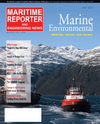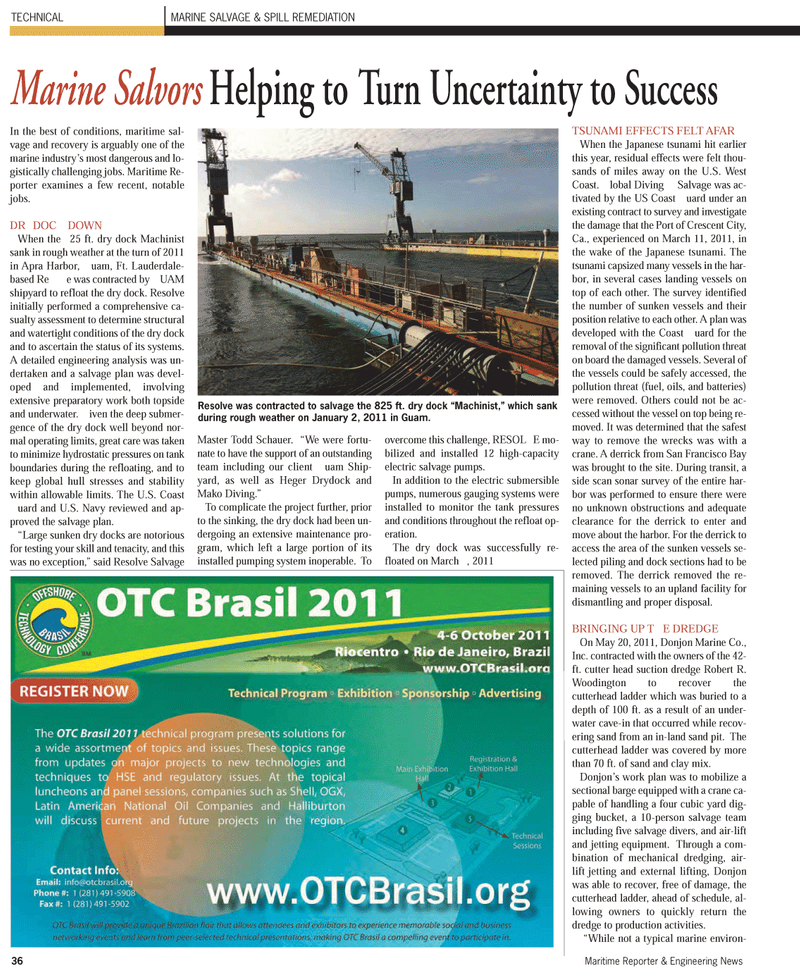
Page 36: of Maritime Reporter Magazine (July 2011)
The Green Ship Edition
Read this page in Pdf, Flash or Html5 edition of July 2011 Maritime Reporter Magazine
In the best of conditions, maritime sal-vage and recovery is arguably one of the marine industry?s most dangerous and lo- gistically challenging jobs. Maritime Re-porter examines a few recent, notable jobs.DRDOC DOWN When the 25 ft. dry dock Machinist sank in rough weather at the turn of 2011in Apra Harbor, uam, Ft. Lauderdale- based Ree was contracted by UAM shipyard to refloat the dry dock. Resolve initially performed a comprehensive ca- sualty assessment to determine structuraland watertight conditions of the dry dock and to ascertain the status of its systems.A detailed engineering analysis was un- dertaken and a salvage plan was devel- oped and implemented, involving extensive preparatory work both topside and underwater. iven the deep submer- gence of the dry dock well beyond nor- mal operating limits, great care was taken to minimize hydrostatic pressures on tankboundaries during the refloating, and tokeep global hull stresses and stability within allowable limits. The U.S. Coast uard and U.S. Navy reviewed and ap- proved the salvage plan. ?Large sunken dry docks are notorious for testing your skill and tenacity, and this was no exception,? said Resolve Salvage Master Todd Schauer. ?We were fortu- nate to have the support of an outstanding team including our client uam Ship- yard, as well as Heger Drydock and Mako Diving.? To complicate the project further, prior to the sinking, the dry dock had been un-dergoing an extensive maintenance pro- gram, which left a large portion of its installed pumping system inoperable. To overcome this challenge, RESOLE mo- bilized and installed 12 high-capacityelectric salvage pumps. In addition to the electric submersiblepumps, numerous gauging systems wereinstalled to monitor the tank pressuresand conditions throughout the refloat op-eration. The dry dock was successfully re- floated on March , 2011 TSUNAMI EFFECTS FELT AFAR When the Japanese tsunami hit earlierthis year, residual effects were felt thou- sands of miles away on the U.S. West Coast. lobal Diving Salvage was ac- tivated by the US Coast uard under an existing contract to survey and investigate the damage that the Port of Crescent City, Ca., experienced on March 11, 2011, in the wake of the Japanese tsunami. The tsunami capsized many vessels in the har- bor, in several cases landing vessels on top of each other. The survey identified the number of sunken vessels and their position relative to each other. A plan was developed with the Coast uard for the removal of the significant pollution threat on board the damaged vessels. Several of the vessels could be safely accessed, the pollution threat (fuel, oils, and batteries)were removed. Others could not be ac- cessed without the vessel on top being re- moved. It was determined that the safest way to remove the wrecks was with a crane. A derrick from San Francisco Bay was brought to the site. During transit, a side scan sonar survey of the entire har- bor was performed to ensure there were no unknown obstructions and adequate clearance for the derrick to enter andmove about the harbor. For the derrick to access the area of the sunken vessels se- lected piling and dock sections had to beremoved. The derrick removed the re- maining vessels to an upland facility for dismantling and proper disposal.BRINGING UP TE DREDGE On May 20, 2011, Donjon Marine Co.,Inc. contracted with the owners of the 42- ft. cutter head suction dredge Robert R.Woodington to recover the cutterheadladder which was buried to a depth of 100 ft. as a result of an under- water cave-in that occurred while recov- ering sand from an in-land sand pit. The cutterheadladder was covered by more than 70 ft. of sand and clay mix. Donjon?s work plan was to mobilize a sectional barge equipped with a crane ca- pable of handling a four cubic yard dig-ging bucket, a 10-person salvage team including five salvage divers, and air-lift and jetting equipment. Through a com- bination of mechanical dredging, air- liftjetting and external lifting, Donjon was able to recover, free of damage, the cutterheadladder, ahead of schedule, al- lowing owners to quickly return the dredge to production activities. ?While not a typical marine environ- 36Maritime Reporter & Engineering News MARINE SALVAGE & SPILL REMEDIATION TECHNICALMarine Salvors Helping to Turn Uncertainty to Success Resolve was contracted to salvage the 825 ft. dry dock Machinist,? which sankduring rough weather on January 2, 2011 in Guam.

 35
35

 37
37
